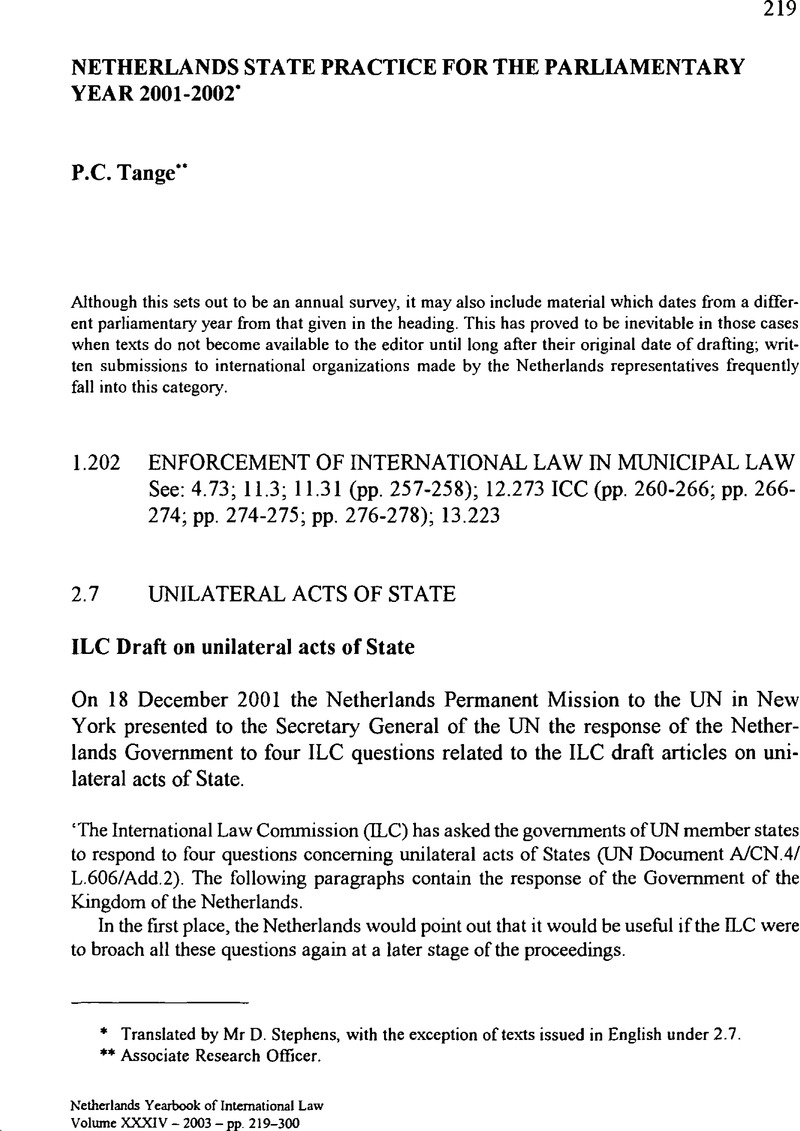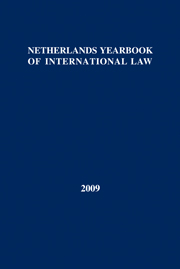No CrossRef data available.
Article contents
Netherlands state practice for the parliamentary year, 2001–2002*
Published online by Cambridge University Press: 07 July 2009
Abstract

- Type
- Documentation
- Information
- Copyright
- Copyright © T.M.C. Asser Press 2003
References
1. Article 1, ’Definition of unilateral acts; For the purposes of the present articles, “unilateral act of a State” means an unequivocal expression of will which is formulated by a State with the intention of producing legal effects in relation to one or more other States or international organizations, and which is known to that State or international organization.’
Article 2, ’Capacity of States to formulate unilateral acts; Every State possesses capacity to formulate unilateral acts.’
Article 3, ’Persons authorized to formulate unilateral acts on behalf of the State; (1) Heads of State, heads of Government and Ministers for Foreign Affairs are considered as representatives of the State for the purpose of formulating unilateral acts on its behalf. (2) A person is also considered to be authorized to formulate unilateral acts on behalf of the State if it appears from the practice of the States concerned or from other circumstances that their intention was to consider that person as authorized to act on behalf of the State for such purposes.’
Article 4, ‘Subsequent confirmation of an act formulated by a person not authorized for that purpose; A unilateral act formulated by a person who is not authorized under article 3 to act on behalf of a State is without legal effect unless expressly confirmed by that State. (a), General rule of interpretation; (1) A unilateral act shall be interpreted in good faith in accordance with the ordinary meaning given to the terms of the declaration in their context and in the light of the intention of the author State. (2) The context for the purpose of the interpretation of a unilateral act shall comprise, in addition to the text, its preamble and annexes. (3) There shall be taken into account, together with the context, any subsequent practice followed in the application of the act and any relevant rules of international law applicable in the relations between the author State or States and the addressee State or States, (b) Supplementary means of interpretation; Recourse may be had to supplementary means of interpretation, including the preparatory work and the circumstances of the formulation of the act, in order to confirm the meaning resulting from the application of article (a), or to determine the meaning when the interpretation according to article (a): (a) Leaves the meaning ambiguous or obscure; or (b) Leads to a result which is manifestly absurd or unreasonable.’
2. The response is based on the Advisory report of the Advisory Committee on issues of public international law of 16 October 2001, published in Jaarverslag 2001 van de Commissie van advies inzake volkenrechtelijke zaken, annex 3, pp. 1–2. The Advisory report was nearly unchanged adopted by the Minister for Foreign Affairs, see Jaarverslag 2001, p. 3.
3. Bijl. Hand. II 2001/2002 – 28000VI No. 64, pp. 5–6; 6–7.
4. Bijl. Hand. II 2001/2002 – 19637 No. 634, p. 2.
5. Bijl Hand. I/II 2001/2002 – 28100 (R 1705) Nos. 129 and 1, pp. 3–4; 4–5.
6. Vienna Convention on Consular Relations and Optional Protocols, Vienna, 24 April 1963, Article 36.
7. Bijl. Hand. II 2001/2002 25203 No. 16, p. 2.
8. Bijl. Hand. II 2001/2002 28029 (R1700) No. 3, pp. 4–7.
9. See 30 NYIL (1999) p. 315.
10. See 32 NYIL (2001) pp. 202–296.
11. Bijl. Hand. II 2001/2002 28337 No. 3, pp. 1–3; 4–13; 16–25.
12. Bijl. Hand. II 2001/2002 27925 No, 17, pp. 1–3.
13. Bijl. Hand. II 2001/2002 28028, 28029 (R 1700), 28030 (R1701), 28031 No. 13, pp. 4–5.
14. Bijl. Hand. II 2001/2002 28463 No. 3, p. 1, 2, 3.
15. Hand. II 2001/2002 No. 82, pp. 4982–4983; 4995.
16. See 33 NYIL (2002) pp. 191–194.
17. See 26 NYIL (1995) pp. 254–261 and p. 321.
18. See 29 NYIL (1998) pp. 181–182.
19. Bijl. Hand. II 2001/2002 28098 (R 1704) No. 3, pp. 1–3; 3–7.
20. Bijl. Hand. II 2001/2002 28098 (R 1704) and 28099 No. 13.
21. Bijl. Hand. II 2001/2002 28099 No. 3, pp. 1–2; 2–3.
22. See NYIL. (2002) p. 373.
23. Bijl. Hand. II 2001/2002 28098 (R 1704) and 28099 No. 12, pp. 18–19; 20–21.
24. The Military Technical Agreement (MTA) is an agreement between the International Security Assistance Force (ISAF) and the Interim Administration in Afghanistan concerning arrangements for assistance to ISAF and related technical matters.
25. Bijl. Hand. II 2001/2002 27925 No. 62, pp. 2–3.
26. Bijl. Hand. II 2001/2002 – 28000V No. 68.
27. Bijl. Hand. II 2001/2002 27454 (R 1668) No. 7, pp. 1–3.
28. Available for inspection at the Central Information Point of the House of Representatives of the States General.
29. Bijl. Hand. II 2001/2002 27925 No. 35, pp. 1–2.
30. A proposal for an assessment framework has been included in Section 6 of this Memorandum.
31. The letter (Doc. S/2001/535 of 5 May 2001) was signed by Argentina, Canada, Ghana, India, Jordan, the Netherlands and New Zealand.
32. Bijl. Hand. II 2001/2002 27742 No. 5, pp. 2–3; 5–11; 12–13.
33. Hand. II 2001/2002 No. 95, p. 5666
34. Council Regulation (EC) No. 2062/2001 of 19 October 2001, OJ L 227; Council Regulation (EC) No. 2199/2001 of 12 November 2001, OJ L 295; and Council Regulation (EC) No. 2580/2001 of 27 December 2001, OJ L 344.
35. Bijl. Hand. II, 2001–2002, 27 925, No. 17, see this Yearbook under 11.31.
36. Bijl. Hand. II, 2001–2002, 27 925, No. 10.
37. Bijl. Hand. II 2001/2002 28251 No. 3, pp. 1–2.
38. Hand. II 2001/2002 No. 72, pp. 4719–4720; 4720–4721.
39. Hand. II 2001/2002 No. 10, pp. 447–448.
40. Hand. II 2001/2002 No. 24, pp. 1763; 1767.
41. Hand, I 2001/2002 No. 18, p. 924.
42. Bijl. Hand. II 2001/2001 23432 No. 43.


